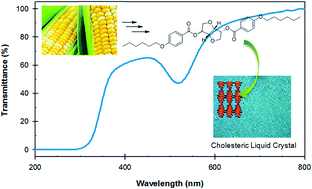Bio-based chiral dopants having an isohexide skeleton for cholesteric liquid crystal materials†
Abstract
Chiral dopants were synthesized from bio-based epimeric isohexides (

* Corresponding authors
a
Green Process and Materials Research Group, Korea Institute of Industrial Technology (KITECH), 35-3 Hongcheon-ri, Cheonan, Republic of Korea
E-mail:
shshin@kitech.re.kr
Fax: +82 41-589-8580
b Department of Nanobiomedical Science and WCU Research Center of Nanobiomedical Science, Dankook University, 201 Manghyang-ro, Cheonan, Republic of Korea
Chiral dopants were synthesized from bio-based epimeric isohexides (

 Please wait while we load your content...
Something went wrong. Try again?
Please wait while we load your content...
Something went wrong. Try again?
S. Shin, J. W. Seo, J. K. Cho, S. Kim, J. Cha and M. S. Gong, Green Chem., 2012, 14, 1163 DOI: 10.1039/C2GC16261J
To request permission to reproduce material from this article, please go to the Copyright Clearance Center request page.
If you are an author contributing to an RSC publication, you do not need to request permission provided correct acknowledgement is given.
If you are the author of this article, you do not need to request permission to reproduce figures and diagrams provided correct acknowledgement is given. If you want to reproduce the whole article in a third-party publication (excluding your thesis/dissertation for which permission is not required) please go to the Copyright Clearance Center request page.
Read more about how to correctly acknowledge RSC content.
 Fetching data from CrossRef.
Fetching data from CrossRef.
This may take some time to load.
Loading related content
